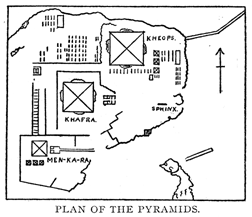
IV — THE PYRAMIDS, KHEOPS AND HIS SUCCESSORS
Time mocks all things; the pyramids mock time.
The Fourth Dynasty is commemorated as the most brilliant of all in that remote period of Egyptian history. There had come the introduction of a new era in Egyptian affairs. It has been conjectured by distinguished writers that there had been a rupture before between Lower and Upper Egypt. The two crowns, nevertheless, were united under Seneferu, and he had extended his dominion into Libya, the peninsula of Sinai, and southward to Abyssinia. He had thus opened for his successors new opportunities for enterprise and developed new perceptions of power and position.
It is not easy, however, to measure the extent of the change or even to elucidate the causes. The Egyptians had, at this period, about the same settled ways as in later times. They had not the primitive habits or barbarous customs as in other countries and they did not wear arms when not engaged in warfare. Religion and knowledge had with them the preference, and they had little aspiration for war and conquest. They were essentially domestic, fond of art, and social in their manners. Their arts were similar and even superior to those of later centuries.
The kings of the Fourth Dynasty are described by Manetho as belonging to a different family from the preceding monarchs. There had been intermarriages of royal princes with the nobles and priests and probably with foreign personages. At the failure of a Dynasty there were liable, therefore, to be disputed titles, and often several individuals claiming each to be the genuine sovereign. In such cases the partisans of each would name their particular favorites, and the different records would thus be made to exhibit discrepancies in respect to the names and extent of reigns, which would puzzle later inquiry.
The extinction of the first Memphite family, now known to us as the Third Dynasty and the accession of the succeeding one was an example of this. There is, however, a record in the monuments of a queen, Mertiteps, whom King Seneferu held in superior esteem, and who was in equal favor with Khufu of the Fourth Dynasty and with Khafra, his successor. This would seem to indicate that whatever contests may have occurred about the royal succession, her connection with public affairs was a powerful factor in determining the result. Indeed, Seneferu set the direction on the current which his successors so persistently followed. He was at once a builder and a conqueror. The Hamitic races everywhere, in Egypt, Arabia, Middle and Southern Asia, and probably in Asia Minor, Greece and Italy were the building races of antiquity, and the remains of their great works exist as a demonstration. They built for the future, and we may not wonder that they had a god, as in Egypt, who was a demiurgos or architect.

The first monarch of the Fourth Dynasty was Ser or Suri, as given by the monuments, Soris as he was named in the Chronicle of Manetho. He reigned as is previously recorded for a period of nineteen or twenty-nine years. Some writers have identified him with Seneferu, and others with his successor; as certainly there seems to be no separate memorial of his achievements, (1) which sets forth the fact positively.
The next king, Khufu or Kheops, is accordingly represented as the legitimate head, if not the actual founder of the new Dynasty. Notwithstanding his achievements as a ruler he is best remembered as the builder of the Great Pyramid. It would be superfluous to attempt a description of this structure, but it will be of interest to consider its purpose, character and the conditions incident to its erection. The motive that impelled the work was essentially religious. Without such a prompting it is hard to conceive that so many thousand men could be kept steadily employed at the work. Lieut. Wilford of the East Indian Service has given corroborating evidence. (2) While he was describing the structure to several Brahmans they asked whether there was not a communication underground with the River Nile. He replied that such a passage had been mentioned as having once existed. (3) They told him that the Pyramid was a temple for the worship of the Padma Devi. (4) and that the supposed tomb was a trough to be filled at the festivals with holy water and lotus-blossoms.
This statement that the pyramid was a religious shrine is verified by the facts that existed at the time. The kings of Egypt were regarded as sacred personages and revered as gods. The pyramids were not only their monuments and sepulchres, but sanctuaries, each with a staff of priests and prophets by whom their worship was conducted till the revolutions in later centuries effected its overthrow.
It is a curious question, nevertheless, how the conception of such structures came to be entertained in Egypt. The Mound and the Pyramid had a very remote antiquity. They abounded in India and in ancient America at periods and races older than history. The teo-callis of Mexico and Central America may help at explanation when more shall have been learned.
Several of the kings of Egypt before the Fourth Dynasty are supposed to have erected pyramids, but these were very different from the structures which have such world-wide fame. Whether we may include in this category the Bemas or "high places" (5) of Palestine, they are nevertheless described as sanctuaries of worship at which priests and prophets statedly officiated, as at the tombs and pyramids of Egypt.
The Great Pyramid in Middle Egypt was named Khut, the Flame. This designation is suggestive of an altar with the "eternal fire" upon it, and the glowing light from the burnished surface would seem to corroborate this surmise. It was built of limestone quarried from the mountain near by in the district of Ta-rao, the "Egyptian Troy," and was covered with blocks of glittering granite of huge dimensions which had been brought all the way from Syene or Assuan near the southern boundary of the country. The extraordinary skill, erudition and achievement then diffused over Egypt and manifested in a structure of this character and other works of art are eloquently described by Mr. Gliddon: "Philologists, astronomers, chemists, painters, architects, physicians must return to Egypt to learn the origin of language and of writing — of the calendar and solar motion — of the art of cutting granite with a copper chisel and of giving elasticity to a copper sword — of making glass with the variegated hues of the rainbow — of moving blocks of polished syenite nine hundred tons in weight for any distance by land and water — of building arches round and pointed, and antecedent by 2,000 years to the 'Cloaca Magna' of Rome, of sculpturing a Doric column 1,000 years before the Dorians are known in history, of fresco paintings in imperishable colors and of practical knowledge of anatomy."
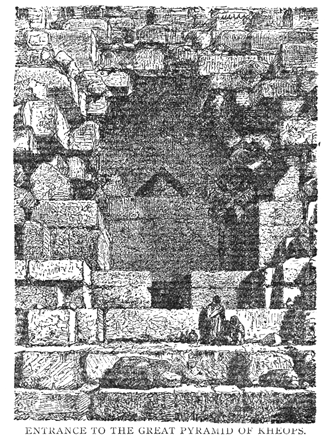
In the times of Persian and Roman ascendancy, the kings who built these pyramids were denounced by writers in energetic terms. It is said that a hundred thousand men at a time were drafted in turn under the system of corvee, and employed for twenty years upon the Great Pyramid. Herodotos has preserved a mutilated story which, however true in its tenor, is not in accordance with the verities of history. The priests told him that Egypt was excellently governed and flourished greatly till the death of Rampsinitos, or Rameses III. After this monarch Kheops succeeded to the throne and plunged into all manners of wickedness. "He closed the temples and forbade the Egyptians to offer sacrifice, (6) compelling them instead, to labor one and all in the service."
Manetho corroborated this statement by the declaration that Kheops "was arrogant toward the gods, but repenting, he wrote the Sacred Book." But Lauth, himself an eminent Egyptologist, has ingeniously exonerated this king from these imputations. He shows that the Greeks often understood Egyptian terms by the meaning of words in their own language that resembled them in form. Thus the "Sacred Book" which Khufu compiled has as its introduction the term ha-sebait, the beginning of basis of instruction. The Greek word asebeia which is like it in form and sound denotes impiety and so doubtless occasioned the error. We can easily perceive that this notion, so manifestly a perversion, may have led to the imputation upon the character of the monarch and finally to the erasing out of the Papyrus Prisse, the "Sacred Bo" which he compiled, and which was venerated by the Egyptians till the latest dynasties. Since that period religious bigotry in other countries has induced similar destructions of literature and calumny of the authors.
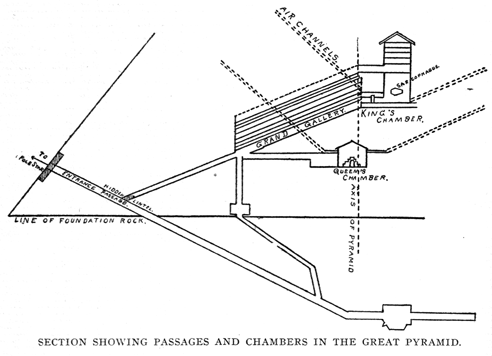
The testimony of the monuments, however, vindicates this king as a prince of merit. He appears to have introduced the worship of the god Num or Neph into Lower Egypt, and an inscription upon a tablet at the mouth of a mine in the Wadi Magara in the Peninsula of Sinai designates him as Num-Khufu, and pictures him in the act of smiting an Asiatic enemy while the ibis-headed divinity stands by as witness. Manetho also describes him as attaining a place among the gods.
There was, however, a singular reserve exhibited in the inscriptions. The king, wherever named, is mentioned with diffidence; and no divinity or religious rite is alluded to except with a carefulness as though familiar speech was not reverent. Nor was literature enriched by the "Sacred Book" alone. A papyrus now in the British Museum, mentions a manuscript relating to the cure of wounds which was found in the days of Khufu in the temple of Teb-mut.
Around the great building were the tombs of the nobles, many of whom were members of the royal family. The inscriptions mention also the wife of Khufu and likewise a person named Khufu-Seph. Offerings are also described of images given by Khufu to the gods. These were of stone, gold, ivory and ebony. An inscription of a later date records that he built a temple to the goddess Hathor at Dendera, also several others. Architecture had attained a degree of perfection which has never since been equaled, and there was a Canon of Proportion in sculpture which was always strictly followed.
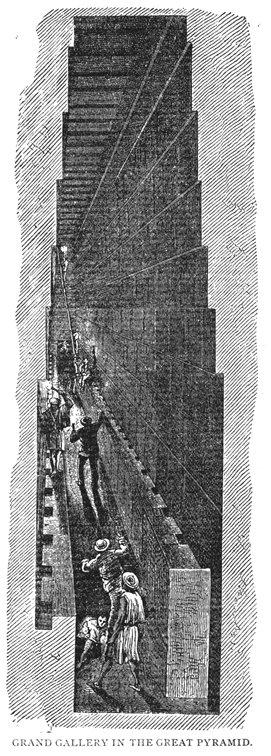
Khufu may have lived to a ripe old age. Both he and his successor, Khafra or Khe-phrenes, are recorded as reigning sixty-three years. There was a practice of many monarchs to associate the heir apparent with them in the later years of their reign. This was a device to prevent a disputing of the succession, (7) and in this case induced some confusion.
The new king is known to us chiefly by his buildings. The Greeks suppose him to have been a son or brother of Khufu, and it has been conjectured that his consort, the queen Meris-ankh, was daughter of that monarch. She was of exalted rank and character, the priestess of the god Thoth and also a ministrant in the worship of several other divinities. Her son, the prince Neb-ema-khut, was a hierogram-mateus or temple-scribe and held the post of secretary of state and privy counsellor to his father.
We are informed by Herodotos that Khafra "imitated the conduct of his predecessor, and like him built a pyramid of less dimensions than that of his father and having no subterranean apartments nor any canal from the Nile to supply it with water as the other pyramid has."
These two structures stand side by side and in line with them at the East is the huge figure of the Sphinx. This is a monument still older, and neither its design, age nor architect is known. (8) In form it is the likeness of a recumbent lion's body with a human head, and its height is measured at one hundred and eighty-two feet. It was hewn out of the living rock, part of the structure being built up by masonry. It commonly had a designation of "Hu," the lion, and in its character of divinity it also bore the name of Hor-ma-khu, or Horos in the western sky, afterward changed by the Greeks into Harmakhis and Harmais. At the breast of this wonderful image there was a temple which was built of huge blocks of granite from Syene, exquisitely cut and polished and fitted together. This structure was evidently both a tomb and sanctuary. Khufu seems to have taken it for a shrine of that divinity. There was a temple of Isis at the north of the Sphinx, another of Osiris at the South and the one consecrated to the divine image as Horos, their son. The inscriptions set forth that Khufu went to the Sphinx in order to obtain a view of the heavenly face of his father. Both Khufu and Khafra were named together in the inscriptions on the sculptured walls of the Great Pyramid, and the two apartments in that structure were their funeral chambers. An inscription made in a later dynasty preserves a memorial of Khufu:
"He, the living Horos — Khufu, King of Lower and Upper Egypt — he, the dispenser of life — found a sanctuary of the goddess Asa (Isis), the queen of the pyramid, beside the temple of the Sphinx, northwest from the temple of Usar (Osiris), the lord of the abodes of the dead. He built this pyramid near the temple of that goddess, and he built a pyramid for the king's daughter, Hentsen, near this temple."
The inscription further exhibits the king's religious enthusiasm:
"He, Khufu, the living Horos, king of the Lower and Upper Country, caused the holy utensils, the pattern of which is shown on the surface of the monument, to be consecrated to his mother Isis the mother of God, who is Hathor, the ruler and mistress of the world of the dead. He has established anew her divine worship, and has built for her the temple in stone, choosing for her the company of the heavenly inhabitants of her dwellings."
This testimony was engraved on the rock a century and more before Herodotos, misled probably by his informants, wrote down his calumnious statements. Lauth of Munich has added to our knowledge of this matter by deciphering an inscription in the Louvre at Paris, which shows that in the later centuries of Egyptian history these very kings were worshipped, together with the gods. It gives the pedigree of the priest Psametik, and describes him as "prophet of the god Tanen, prophet also of Isis the queen of the pyramids, prophet furthermore of King Khufu, prophet of King Khafra, prophet of the divine Tataf-Ra, prophet of Hormakhu."
M. Brugsch-Bey has graphically described the finding of the building which had been buried in the sand that encircles the image of the Sphinx. He declared it "a mystery to those who inquire into the age, origin, construction and object of the whole work. Small passages, then spacious halls, then again dark side-rooms, built with huge well-cut blocks of variegated stone of yellow alabaster, fitted to a hair's breadth, block to block, each alternate corner-stone being clamped into the adjacent wall, all smooth and well adjusted in straight lines and perfectly square, but destitute of any mark or inscriptions. The building appears a mysterious work of antiquity, when history had not yet been written."
On the east side the space of ground covered with stone showed in a long hall the shaft of a well. Into this had been thrown a number of statues of King Khafra. This may have been done by invaders of Egypt, or by Christian or Moslem religionists in their zeal against images. Most of them were broken in falling. One, however, escaped destruction. This was a figure of King Khafra carved out of the hard diorite stone. It was of royal aspect, dignified in look and bearing. The name and title of the monarch were inscribed on the base.
Egyptian life had already taken on the form which it retained till the Persian conquest. The scenes depicted in the sculptured tombs of this epoch show this conclusively, and the hieroglyphics in the great pyramid which were written in the cursive character on the stones before they were taken from the quarry indicate that the art of writing had been long in use. The pyramids themselves correspond in position with the four cardinal points, exhibiting advancement in mathematical knowledge; and the blocks of immense size and weight, many of which had been brought from Syene, were put together with a precision unsurpassed by any masonry of former or later times. In the tombs of the pyramid period, Sir J. Gardner Wilkinson remarks, "There are represented the same fowling and fishing scenes, the rearing of cattle and wild animals of the desert; it describes the same kind of reed for writing on the papyrus and inventory of the estate which was to be presented to the owner; the same boats, though rigged with a double mast instead of the single one of later times; the same mode for preparing for the entertainment of guests; the same introduction of music and dancing; the same trades, as glass-blowers, cabinet makers, and others; as well as similar agricultural scenes, implements and granaries. We also see the same costume of the priests; and the prophet of Sam, with his leopard's skin dress (9) and the painted sculptures both in relief and intaglio.
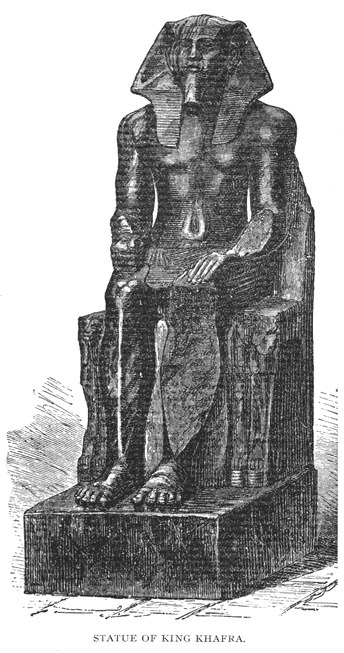
The landed property had to a very great degree come into the possession of the priests and nobles. They enjoyed abundant wealth, and they spent their time in a diligent supervision of their estates, and in superintending the various handicrafts that were pursued by their servants and others in their employ. Every one of them had his secretaries, his steward and domestics, his glass-blower, goldsmith, potter, tailor, baker and butcher. He did not at that early period own a horse or carriage, but rode upon an ass. His fare was luxurious; he abhorred pork and had little relish for mutton, but he was fond of beef, venison and poultry, and did not disdain to eat the flesh of the hyena, the crane or the heron. Indeed, the "flesh-pots of Egypt" were supplied with an abundance that might well cause a famished Israelite in the Arabian Desert to wish himself back among them, though at the price of subjection.
Even the commonalty possessing little wealth, appear to have led a cheerful life. Industry is necessary to happiness as well as to the general welfare, and the Egyptian Fellah of that early time had little occasion for discontent. However imperative the requirements of the corvee, he was little burdened by taxation or liable to be forced away from home to serve in the army. It was a merit of deceased kings at the Assize of the Dead, that they had not torn the poor man away from the side of his wife. The religious belief of Egypt centered upon the future of the soul, and its requirements were comprised in devotion to the gods, obedience to the king, family affection, and in giving bread to the hungry, clothes to the naked, drink to the thirsty, healing medicines to the sick and wounded and burial to the dead. He was also requested to show that he had not deposited any dead or polluting substance in the river Nile. With such virtues inculcated for the daily life, and an implicit faith in the law of consequences for every act and in the constant presence and influence of divine beings and deceased benefactors, the Egyptians of all ranks appeared to have enjoyed their full share of benefits.
Upon the death of Khafra, Men-ka-ra, or Mykerinos, the son of Khufu, succeeded to the throne. Herodotos records of this prince that he opened again the temples and permitted the people who had been ground down to the lowest point of misery to return to their occupations and to resume their practice of sacrifice. It is also related that he not only gave his judgment with fairness, but when any litigant was dissatisfied with the decision he compensated him for the disappointment by an adequate gift.
Herodotos has repeated other stories still more improbable respecting this monarch. His only daughter dying, the king was said to have placed her body inside the wooden image of a cow which stood in the royal palace at Sais. The apartment was lighted by a lamp every night and aromatics were burned before it daily. In an adjoining chamber were about twenty nude figures of women whom the priests described as the royal concubines. Another story accused the king of violence toward his daughter, who thereupon committed suicide. The historian, however, had been duped by his informants. The figure at Sais represented the goddess Isis, and was taken from the apartment and publicly exhibited at the time of mourning for Osiris. Another statement that Men-ka-ra reigned only six years from that is contradicted by other historians, and Manetho assigns to him sixty-three years.
Despite the statements of Herodotos it appears certain that this king received in later times no special honor beyond other monarchs. It is interesting, however, to learn that the king's son, Hor-to-tef, undertook a journey to inspect the temples of Egypt and found at Hermopolis a tablet of alabaster on which was a chapter of the Sacred Ritual which was said to have been written by the finger of the god Thoth.
This monarch is distinguished as the builder of the third of the largest pyramids. This structure has been praised by admirers as the most sumptuous and magnificent of all the pyramids. Different stories, however, have been told in respect to its founder. Herodotos mentions a rumor, ascribing it to Rhodopis, a native of Thrace, who lived at Naukratis at the time of the Persian conquest. Strabo gravely states that when she was bathing one day, the wind carried away her sandal and laid it at the feet of the king of Egypt as he was holding court in the open air. He found out the owner and married her. But a more plausible tradition named Queen Naith-akra or Neitokris of the Sixth Dynasty as the actual builder and Mametho also affirms this. There was, however, another queen of that name, the wife of Psametik III of the Twenty-sixth Dynasty, and to this coincidence the different stories doubtless owe their origin.
The question, however, has been determined by actual exploration. Gen. Howard Vyse having succeeded in making his way to the middle of the building, found there the sarcophagus of the king, a receptacle hewn out of a single block of stone and beautifully ornamented on the outside after the style of an ancient temple of a god. Inside of this was a coffin of cedar wood in the form of a mummy standing on a pedestal. Inscribed upon the coffin was an invocation to the god of the Underworld:
"O Osiris, King of Lower and Upper Egypt, Men-ka-ra, the ever-living, begotten of Heaven, son of Nut and heir of Seb, may she, thy mother Nut spread herself over thee and encompass thee; may she cause that thou shalt become divine, and that thy enemies shall come to nothing, O Men-ka-ra, the ever-living!"
This invocation reveals to us the wonderful change that had occurred in the Egyptian thought and consciousness. Heretofore Anup or Anubis, the guide of souls out of this life into the next, had been addressed in these inscriptions. If there was an ulterior meaning to this, it has not been understood. Now, however, Osiris is distinctly named and the deceased monarch is called upon as being at one and united with him. The drama of death was distinctly comprehended as including the whole mystery of life.
The next king of Egypt was Shepses-kaf. Little is known of him, and that little relates chiefly to individuals about his court. A youth by the name of Ptah-shepses had been adopted by Men-ka-ra and brought up in the royal family. The new king continued his favor and gave him his own daughter in marriage. The account as given in the tomb of the favorite is very expressive:
"And His Holiness gave him the eldest of his own daughters, the Princess Maat-kha, to be his wife. And His Holiness preferred that she should dwell with him rather than with any other man."
The story of this prince exhibits a close analogy with that of the patriarch Joseph in the Book of Genesis. Of the latter we read that from a slave and prisoner he was set over all Egypt. "Thou shalt be over my house, and according to thy word shall my people be ruled," said the Pharaoh, "only in a throne will I be greater than thou." In like manner Shepses-kaf honored and ennobled the comrade of his own earlier years. "He was esteemed by the king above all his servants," the record declares. "He became private secretary for every work that Pharaoh was pleased to execute. He delighted the heart of his master, His Holiness allowed him to embrace his knees and exempted him from the salutation of the ground." (10)
Ptah-Shepses, like Joseph, was thus exalted above all princes and subjects. He was chief steward of all the royal granaries and storehouses; he directed the work at the mines, and exercised sacerdotal functions. He was not only a prophet of Sakar-Osiris and guardian of his sanctuary, but he held the highest dignity of all, that of chief over the priesthood of the god Ptah at Memphis.
Shepses-kaf was distinguished for his zeal in religion, his skill in science and his ability in statesmanship. Diodoros ranked him as one of the five great lawgivers of Egypt. In his reign there was a scarcity of money and corresponding difficulty in credits, and in order to facilitate commercial dealings the remarkable law was enacted which has been the marvel of later ages. The borrower was authorized to pledge the mummy of his father, and when this took place the tomb passed into the custody of the creditor. Neither the debtor nor any member of his family was permitted to receive burial anywhere till the debt was paid. This monarch is also credited with the knowledge of practical geometry and astronomy, two sciences intimately connected with the prosperity of Egypt. He was likewise a builder, and erected the fourth gateway to the temple and park of Ptah, which surpassed all the others in magnificence. By no means did he neglect the construction of his pyramid, designated Keba, the cool. It was of brick, and arched, and bore an inscription declaring that notwithstanding its less honored material it surpassed the other pyramids, as the Supreme Being was greater than the other gods.
We have no accurate data in regard to the successors of this monarch. The Chronicle of Manetho gives the names of several kings, but the record has been tampered with. The destruction of monuments and inscriptions has left us destitute of proper evidence. There was a disputed succession, and subordinate princes of the several districts, some of whom were allied to the royal family, refused allegiance to the suzerainty of Memphis. Finally, in default of representatives in the direct line, competent to maintain supremacy, the house of Khufu ceased to reign.
FOOTNOTES:
1. Indeed, Mr. Samuel Birch considers Seneferu as actually the first king in the Fourth Dynasty and as identical with "the Greek Soris, if indeed," he remarks, "that name does represent another monarch." Eratosthenes, on the other hand, gives Soris the name of Saophis (or Khufu), and names also a second Saophis as succeeding the first, who seems also to be regarded as the same as Kheops, the builder of the great pyramid. (return to text)
2. Asiatic Researches, Vol. III., page 439. (return to text)
3. Herodotos II.,127. "In that pyramid the water of the Nile, introduced through an artificial canal, surrounds an island, where the body of Kheops is said to be." (return to text)
4. The goddess of the Lotus, Lakshmi or Hathor. (return to text)
5. Kings I., iii., 2-4; Chronicles I., xvi, 39-42, and xxi., 29; Samuel 1., vii., 17, and ix., 11-24; Kings II., xxiii., 11, etc. (return to text)
6. This offense was charged upon the Hyk-shos, and the story which Herodotos also recorded that the Egyptians attributed the building of the Pyramids to a "shepherd named Philition," seems like an attempt to represent Kheops and his successors as belonging to that hated race. (return to text)
7. Examples of this are given in the Hebrew writings. Jehosaphat made his son Jehoram his partner in the kingdom (Kings II., viii., 16), and David is recorded in the First Book of the Chronicles as inaugurating Solomon as King in the presence and by the concurrence of all the princes of Israel, the princes of the tribes, the officers of the army and the other members of the royal family. Zadok was also made high priest. (return to text)
8. Tell us — for doubtless thou canst't recollect —
To whom should we assign the Sphinx's fame?
Was Cheops or Cephrenes architect
Of either pyramid that bears his name?
— Horace Smith. (return to text)
9. The Bacchic priest wore a spotted robe of fawn or leopard skin, a nimr; at the rites. This seems to have been an ideograph of Nimrod, the eponym of the Kushite Nimri, named in the tenth chapter of the Book of Genesis. (return to text)
10. The oriental practice of worship, by prostration to the ground and figuratively kissing the feet or the ground at the footstool, appears to have been in fashion at that time. (return to text)